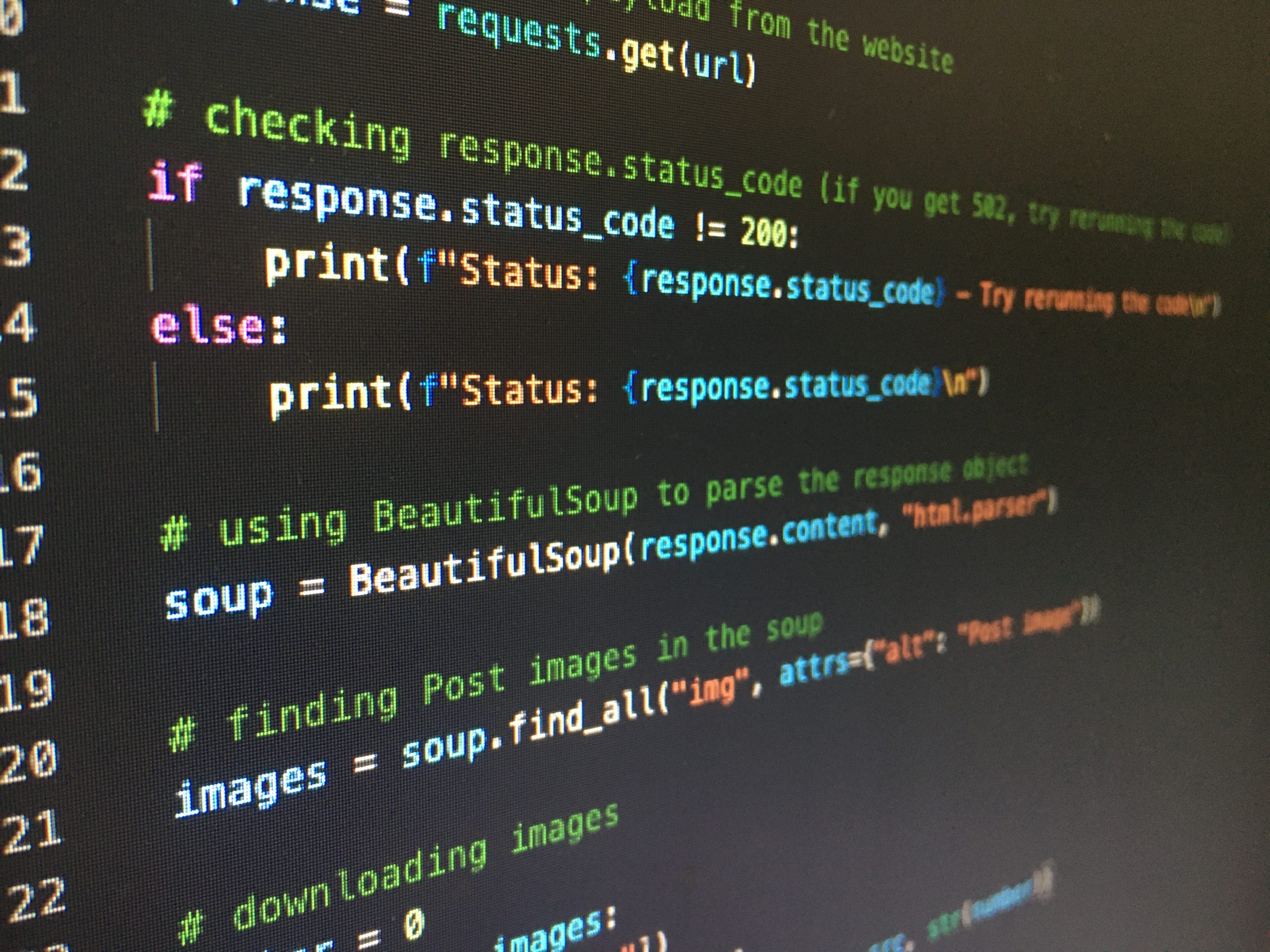Programming is the process of giving a set of instructions to a computer to run a task or set of tasks.
These instructions are used to control the behavior of a computer, allowing it to perform specific tasks, solve problems, and interact with users or other systems.
Programming involves the use of programming languages, which are formal languages designed to communicate instructions to a computer.
This is a complete guide to what is programming. You will learn how code works, why it is important, and much more.

Importance of Programming
Programming has become increasingly important in modern society due to the pervasive nature of technology and the growing reliance on computers, smartphones, and the internet in our daily lives. Here are some key reasons why programming is important:
Driving innovation. Programming enables the development of new technologies, products, and services that can transform industries and improve the quality of life. Innovations such as artificial intelligence, machine learning, and the Internet of Things (IoT) are all driven by programming and software development.
Economic growth. The technology industry is a major contributor to the global economy, generating jobs and wealth. Programmers and software developers play a crucial role in creating and maintaining the digital infrastructure and applications that power businesses, governments, and organizations worldwide.
Problem-solving. Programming teaches critical thinking and problem-solving skills, which are valuable in a wide range of fields. By learning to break down complex problems into smaller, manageable tasks, individuals can become more effective in their personal and professional lives.
Automation and efficiency. Programming allows us to automate repetitive tasks, analyze large amounts of data, and streamline processes, leading to increased productivity and efficiency in various sectors, from manufacturing to finance and healthcare.
Digital literacy. As technology becomes an integral part of our lives, understanding how it works and being able to create or modify digital tools is increasingly important. Programming skills can empower individuals to better navigate and participate in the digital world, making them more informed and adaptable to technological changes.
Education. Programming skills can open up new opportunities for learning in fields such as computer science, engineering, data science, and more. As the demand for skilled programmers continues to grow, acquiring these skills can lead to better career prospects and increased job satisfaction.
Social impact. Programming can be used to address social and environmental issues by developing software solutions that help organizations and communities manage resources, track and analyze data, and make more informed decisions.
Types of Programming Languages
Programming languages can be categorized in various ways based on their features, paradigms, and usage. Here are some common types of programming languages:
Procedural languages: These languages are designed for writing procedures or routines that perform specific tasks, using a sequence of statements and control structures. Examples include C, Pascal, and Fortran. Procedural languages are often used for system programming and general-purpose applications.
Object-oriented languages: These languages are based on the concept of “objects,” which represent real-world entities and encapsulate both data (attributes) and behavior (methods). Object-oriented languages promote modularity, code reusability, and abstraction. Examples include Java, C++, Python, and Ruby.
Functional languages: Functional languages treat computation as the evaluation of mathematical functions, focusing on immutability, the absence of side effects, and the use of higher-order functions. Functional programming can lead to more concise and easier-to-understand code, especially for parallel and distributed systems. Examples include Haskell, Lisp, and Erlang.
Scripting languages: Scripting languages are designed for automating tasks, manipulating data, and controlling other software components. They are often interpreted rather than compiled, which allows for faster development and testing. Examples include Python, JavaScript, Perl, and Ruby.
Markup languages: Markup languages are used to describe the structure, presentation, or meaning of data, typically in the context of web development or document processing. These languages use tags or other markers to annotate the content. Examples include HTML, XML, and CSS.
Query languages: Query languages are designed for retrieving, manipulating, and managing data stored in databases or other structured data formats. Examples include SQL (Structured Query Language) for relational databases, XQuery for XML data, and GraphQL for APIs.
Domain-specific languages (DSLs): DSLs are specialized languages designed for a particular application domain or industry, providing tailored abstractions and syntax to express domain-specific concepts. Examples include MATLAB for mathematical computing, R for statistical analysis, and Verilog for hardware description.
It is important to note that some programming languages can be classified into multiple categories or support multiple programming paradigms. For example, Python is an object-oriented language that also supports functional programming and scripting. The choice of a programming language depends on the specific requirements of a project, the preferences of the developers, and the existing technology stack.
High-Level vs Low-Level Languages
High-level and low-level languages represent two ends of the spectrum in programming languages based on their level of abstraction from the hardware and the ease of human readability.
High-level languages:
- Abstraction: High-level languages provide a greater level of abstraction from the underlying hardware. They are designed to be more human-readable and closer to natural language, which makes them easier to learn, write, and maintain.
- Portability: Code written in high-level languages is generally more portable, meaning it can run on different types of computer systems with minimal or no modification, as long as a suitable compiler or interpreter is available for that system.
- Productivity: High-level languages often come with built-in features, libraries, and frameworks that simplify common programming tasks, allowing developers to write code more quickly and efficiently.
- Compilation/Interpretation: High-level languages require a compiler or interpreter to translate the code into machine code or an intermediate representation before it can be executed by the computer.
Examples of high-level languages include Python, Java, JavaScript, Ruby, and C++.
Low-level languages:
- Abstraction: Low-level languages have a lower level of abstraction, meaning they are closer to the hardware and use instructions that are specific to a particular computer architecture. They provide more control over the hardware but require more detailed knowledge of the system.
- Portability: Code written in low-level languages is less portable, as it often needs to be modified or rewritten to run on different computer systems.
- Efficiency: Low-level languages can produce more efficient and faster-executing code, as programmers have more control over system resources and can optimize for specific hardware.
- Compilation/Interpretation: Low-level languages are typically compiled directly into machine code, which can be executed by the computer without the need for an interpreter.
Examples of low-level languages include assembly language and machine code.
Popular Coding Languages
Python: A versatile, high-level programming language known for its readability and simplicity. Widely used in web development, data analysis, artificial intelligence, and scientific computing.

JavaScript: A scripting language primarily used for client-side web development, allowing developers to create interactive web pages and dynamic content. Also used in server-side development with Node.js.
Java: A platform-independent, object-oriented programming language designed for creating large-scale, distributed applications. Widely used in enterprise software development and Android app development.
C#: A multi-paradigm programming language developed by Microsoft, combining elements of C and C++. Primarily used for developing Windows applications, web services, and games using the .NET framework.
C++: An extension of the C language, C++ is a high-performance, object-oriented language used for system programming, game development, and other resource-intensive applications.
PHP: A server-side scripting language primarily used for web development, enabling the creation of dynamic web pages and content management systems like WordPress.
Ruby: A dynamic, object-oriented programming language focused on simplicity and productivity, often used for web development with the Ruby on Rails framework.
Swift: Developed by Apple, Swift is a powerful and easy-to-learn programming language for developing iOS, macOS, watchOS, and tvOS applications.
Kotlin: A modern, statically typed programming language that is fully interoperable with Java. Primarily used for Android app development and increasingly for server-side and multiplatform applications.
Go (Golang): Developed by Google, Go is a statically typed, compiled language designed for simplicity, concurrency, and efficient execution. Often used for backend services, networking, and cloud-based applications.
How to Write Code
Writing code involves creating a set of instructions for a computer to execute, using a programming language. Here’s a step-by-step guide to help you get started:
Choose a programming language. Based on your project requirements, desired platform, and personal interests, select a suitable programming language to learn and use for your project.
Learn the language syntax. Familiarize yourself with the programming language’s syntax, which includes rules for forming statements, defining variables, and using control structures. There are many resources available, such as tutorials, online courses, books, and documentation.
Set up your development environment. Install the necessary tools to write, compile or interpret, and execute code in your chosen language. This may include a text editor or integrated development environment (IDE), a compiler or interpreter, and any required libraries or frameworks.
Plan your code. Before writing code, analyze the problem you want to solve and create a high-level plan for your solution. Break down the problem into smaller tasks, and outline the steps needed to accomplish each task. Consider using flowcharts or pseudocode to visualize your plan.
Write the code. Start by writing the basic structure of your program, including any necessary imports or includes function or class declarations, and the main entry point (e.g., the main function in C++ or Java). Implement each task, following your plan and the language’s syntax rules. Write clear, concise, and well-organized code, and use meaningful variable and function names.
Comment your code. Include comments throughout your code to explain its purpose, logic, and any assumptions you’ve made. Comments help you and others understand and maintain the code more easily.
Test and debug. As you write your code, test individual components or functions to ensure they work as expected. When you encounter issues, use debugging techniques, such as inserting print statements or using a debugger, to identify and fix errors.
Refactor and optimize. Once your code is working correctly, review it for potential improvements. Refactor your code to make it more readable and maintainable, and optimize it for performance if necessary.
Version control. Use a version control system (e.g., Git) to track changes in your code, maintain a history of revisions, and collaborate with other developers.
Keep learning and practicing. Writing code is an ongoing learning process. As you gain experience, you’ll become more efficient and proficient in problem-solving, debugging, and writing clean, well-organized code.
Remember that programming is a skill that requires practice and patience. Don’t be discouraged by initial difficulties; learn from your mistakes and continue to refine your abilities.
Compilers and Interpreters
Compilers and interpreters are tools that translate code written in a high-level programming language into a format that a computer can understand and execute. They serve different purposes and have distinct characteristics:
Compiler
A compiler is a program that translates the entire source code of a high-level programming language into machine code or an intermediate representation (e.g., bytecode) before execution.
The output of a compiler is typically an executable file or a set of object files that can be linked together. Since the translation occurs before runtime, programs compiled to machine code usually have faster execution speeds.
Some popular compilers include GCC for C and C++, and the Java Development Kit (JDK) for Java.
Interpreter
An interpreter is a program that translates and executes high-level source code line by line during runtime. It reads each line of code, translates it into machine code or an intermediate representation, and immediately executes the translated instructions.
This process is repeated for each line of the program. Interpreted languages generally have slower execution speeds compared to compiled languages but offer greater flexibility and ease of development, as they allow for faster testing and debugging. Some popular interpreters include the Python interpreter (CPython) and the JavaScript interpreter (found in web browsers).
Some languages use a combination of compilation and interpretation, such as Java, which compiles source code into bytecode that is then executed by the Java Virtual Machine (JVM) interpreter. Another example is Python, which can be compiled into bytecode before being executed by the Python interpreter.
It’s actually funny, but the best explanation for compilers vs interpreters is this video:
Even though the video is old, I still find it the best explanation for the topic I’ve seen anywhere.
Execution of Code
Execution of code refers to the process by which a computer carries out the instructions written in a programming language.
The code, which consists of a sequence of statements, is either compiled into machine code or interpreted during runtime.
The computer’s central processing unit (CPU) then reads and performs the instructions in the order specified by the code.
Code execution generally follows these steps:
- Translation: If the code is written in a high-level programming language, it needs to be translated into machine code (a low-level language that the computer can understand) or an intermediate representation. This translation is performed by a compiler or an interpreter, depending on the language.
- Loading: The translated code (machine code or intermediate representation) is loaded into the computer’s memory, where it is accessible for execution.
- Execution: The CPU reads the instructions from memory and performs the specified operations. This can include arithmetic and logical operations, data manipulation, control flow (branching and looping), and interaction with input/output devices.
- Output: The results of the executed code, such as calculations or data manipulation, may be displayed to the user, stored in memory, or written to a file or other storage devices.
The execution of code allows computers to perform complex tasks, solve problems, and interact with users and other systems.
The efficiency and speed of code execution depend on factors such as the programming language, compiler or interpreter, hardware resources, and the optimization of the code itself.
The Need for Coders in the Job Market
The demand for coders in the job market has been steadily increasing over the years due to several factors:
Technological advancements. Rapid developments in technology have led to the creation of new products, services, and industries, all of which require skilled coders to build, maintain, and improve upon them.
Digital transformation. Businesses across various industries are increasingly relying on digital solutions to streamline processes, increase efficiency, and enhance their competitiveness. This digital transformation drives the demand for coders who can develop and implement software systems and applications.
Growing fields. Emerging fields such as artificial intelligence, machine learning, data science, cybersecurity, and the Internet of Things (IoT) require a strong foundation in coding and are driving the demand for skilled programmers.
Mobile and web development. The widespread use of smartphones and the internet has led to an increased need for coders who can create and maintain mobile applications and websites.
Automation. As organizations look to automate repetitive tasks and processes, they need coders to develop the necessary software tools and systems.
Remote work. The rise of remote work opportunities has made it easier for coders to find jobs and collaborate with teams around the world. This has expanded the job market for coders, as businesses can now access a global talent pool.

Cross-disciplinary skills. Coding skills are increasingly valuable in non-technical roles, as understanding and working with technology becomes a critical skill across various fields. This increases the need for coders and programming-literate professionals in the job market.
Resources for Learning How to Code
Does coding start intriguing? Perhaps that’s your future career.
Here are some amazing resources I’ve used as a coder. These resources help both beginners as well as experienced developers to learn.
- Online tutorials and interactive platforms:
- Codecademy (https://www.codecademy.com/): Offers interactive coding lessons in various languages, such as Python, JavaScript, and Ruby.
- FreeCodeCamp (https://www.freecodecamp.org/): Provides free coding lessons, projects, and challenges in web development, including HTML, CSS, and JavaScript.
- W3Schools (https://www.w3schools.com/): Offers tutorials and references for web technologies, including HTML, CSS, JavaScript, and server-side programming.
- Online courses and MOOCs:
- Coursera (https://www.coursera.org/): Offers a wide range of programming courses from top universities and institutions, covering languages like Python, Java, and C++.
- edX (https://www.edx.org/): Provides free and paid programming courses from renowned universities, covering various languages and topics.
- Udemy (https://www.udemy.com/): Offers paid courses on various programming languages and topics, often including practical projects and exercises.
- Books:
- “Python Crash Course” by Eric Matthes: A beginner-friendly book for learning Python programming.
- “Head First Java” by Kathy Sierra and Bert Bates: An engaging and interactive book for learning Java programming.
- “You Don’t Know JS” book series by Kyle Simpson: A comprehensive series on JavaScript for beginners to advanced learners.
- Coding boot camps:
- Le Wagon (https://www.lewagon.com/): Offers full-time and part-time coding boot camps in web development and data science.
- General Assembly (https://generalassemb.ly/): Provides full-time, part-time, and online coding boot camps in web development, data science, and other fields.
- App Academy (https://www.appacademy.io/): Offers full-time and online coding boot camps focused on full-stack web development.
- Coding practice platforms:
- HackerRank (https://www.hackerrank.com/): Provides coding challenges and competitions in various domains, including algorithms, data structures, and artificial intelligence.
- LeetCode (https://leetcode.com/): Offers a collection of coding challenges and problems, primarily focused on preparing for technical interviews.
Final Thoughts
Coding is an important skill to have. It allows businesses to use computers to perform certain actions. Coding is needed everywhere. From developing web apps to running data analysis, coding helps businesses thrive in the bit space.
Learning how to code takes time. These days, there are big communities and a whole bunch of useful resources at your disposal, though.